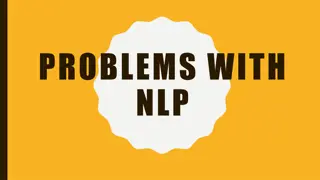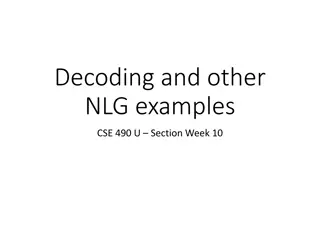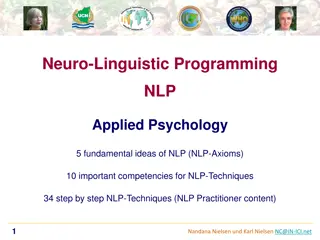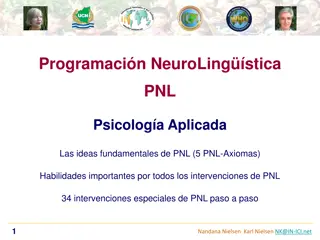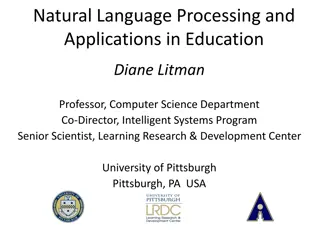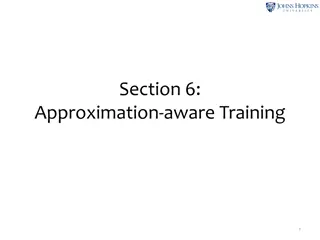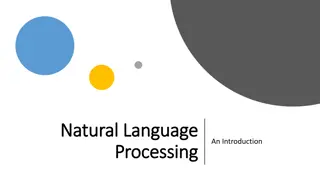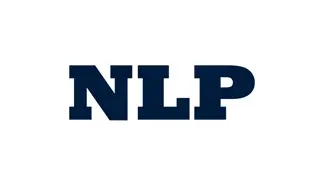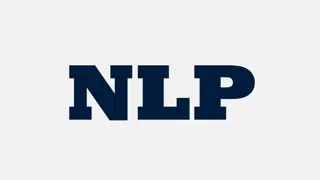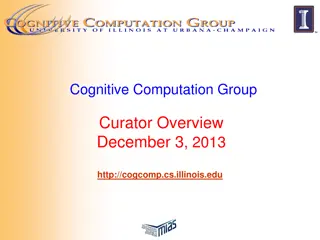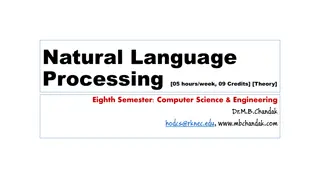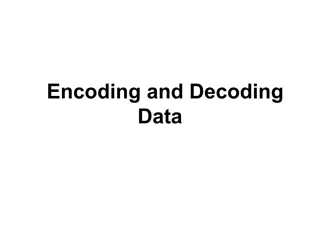Decoding Communication in NLP Models
Large scale language models are the current trend in NLP, emphasizing end-to-end learning for tasks like machine translation. Pre-training language models, such as ELMo and BERT, have shown impressive results. The focus is on understanding and interpreting the internal structure of these models to improve decision-making processes and overall performance.
Download Presentation

Please find below an Image/Link to download the presentation.
The content on the website is provided AS IS for your information and personal use only. It may not be sold, licensed, or shared on other websites without obtaining consent from the author.If you encounter any issues during the download, it is possible that the publisher has removed the file from their server.
You are allowed to download the files provided on this website for personal or commercial use, subject to the condition that they are used lawfully. All files are the property of their respective owners.
The content on the website is provided AS IS for your information and personal use only. It may not be sold, licensed, or shared on other websites without obtaining consent from the author.
E N D
Presentation Transcript
Interpretability and Other Highlights from Natural Language Processing Yonatan Belinkov Decoding Communication in Nonhuman Species Simons Institute, August 4, 2020
Outline Large scale language models as the predominant approach to NLP Interpreting and analyzing them Other NLP topics that might be relevant Grammar induction Unsupervised machine translation Emergent communication in AI agents
End-to-End Learning The predominant approach in NLP these days is end-to-end learning Learn a model f : x y, which maps input x to output y
End-to-End Learning For example, in machine translation we map a source sentence to a target sentence, via a deep neural network:
A Historical Perspective Compare this with a traditional statistical approach to MT, based on multiple modules and features:
End-to-End Learning The predominant approach in NLP these days is end-to-end learning, where all parts of the model are trained on the same task:
Pre-training Language Models Common use case: pre-train a very large model on one task Given raw text, predict a part of it Then, fine-tune it on another task Question answering, sentiment analysis, etc. Many state-of-the-art results ELMo (Peters et al., 2018) BERT (Devlin et al., 2019) Many more green Mary did not slap the ______ witch
How can we open the black box? Given f : x y, we want to ask some questions about f What is its internal structure? How does it behave on different data? Why does it make certain decisions? When does it succeed/fail? ...
How can we open the black box? Given f : x y, we want to ask some questions about f What is its internal structure? How does it behave on different data? Why does it make certain decisions? When does it succeed/fail? ...
Structural Analyses Let f : x y be a model mapping an input x to an output y f might be a complicated neural network with many layers/components For example, fl(x) might be the output of the network at the l-th layer Some questions we might want to ask: What is the role of different components of f (layers, neurons, etc.)? What kind of information do different components capture? More specifically: Does components A know something about property B? Properties may come from different linguistic areas: morphology, syntax, semantics
Structural Analyses Let f : x y be a model mapping an input x to an output y f might be a complicated neural network with many layers/components For example, fl(x) might be the output of the network at the l-th layer
Structural Analyses Let f : x y be a model mapping an input x to an output y f might be a complicated neural network with many layers/components For example, fl(x) might be the output of the network at the l-th layer Analysis via a probing classifier Assume a corpus of inputs x with linguistic annotations z Generate representations of x from some part of the model f, for example representations fl(x) at a certain layer Train a classifier g : fl(x) z that maps representations fl(x) to property z Evaluate the accuracy of g as a proxy to the quality of representations fl(x) w.r.t property z
Structural Analyses Let f : x y be a model mapping an input x to an output y f might be a complicated neural network with many layers/components For example, fl(x) might be the output of the network at the l-th layer Analysis via a probing classifier Assume a corpus of inputs x with linguistic annotations z Generate representations of x from some part of the model f, for example representations fl(x) at a certain layer Train a classifier g : fl(x) z that maps representations fl(x) to property z Evaluate the accuracy of g as a proxy to the quality of representations fl(x) w.r.t property z In information theoretic terms: Set h = f(x) and recall that I(h; z) = H(z) - H(z | h) Then the probing classifier minimizes H(z | h), or maximizes I(h, z)
Milestones (partial list) f x y g z K hn 2015 Word embedding Word Word Linear POS, morphology Ettinger et al. 2016 Sentence embedding Word, sentence Word, sentence Linear Semantic roles, scope Shi et al. 2016 RNN MT Word, sentence Word, sentence Linear / tree decoder Syntactic features, tree Adi et al. 2017 Conneau et al. 2018 Sentence embedding sentence sentence Linear, MLP surface, syntax, semantics Hupkes et al. 2018 RNN, treeRNN five plus free eight Linear Position, cumulative value Hewitt+Manning 2019 ELMo, BERT Sentence Sentence Linear Full tree
Example Results Numerous papers using this methodology to study: Linguistic phenomena (z): phonology, morphology, syntax, semantics Network components (f): word embeddings, sentence embeddings, hidden states, attention weights, etc. We ll show example results on machine translation Much more related work reviewed in our survey (Belinkov and Glass 2019)
Example: Machine Translation Setup f : an RNN encoder-decoder MT model x and y are source and target sentences (lists of words) g: a non-linear classifier (MLP with one hidden layer) z: linguistic properties of words in x or y
Example: Machine Translation Setup f : an RNN encoder-decoder MT model x and y are source and target sentences (lists of words) g: a non-linear classifier (MLP with one hidden layer) z: linguistic properties of words in x or y Morphology: A challenge for machine translation, previously solved with feature-rich approaches. Do neural networks acquire morphological knowledge?
Example: Machine Translation Setup f : an RNN encoder-decoder MT model x and y are source and target sentences (lists of words) g: a non-linear classifier (MLP with one hidden layer) z: linguistic properties of words in x or y Morphology: A challenge for machine translation, previously solved with feature-rich approaches. Do neural networks acquire morphological knowledge? Experiment Take fl(x), an RNN hidden state at layer l Predict z, a morphological tag (verb-past-singular-feminine, noun-plural, etc.) Compare accuracy at different layers l
Machine Translation: Morphology Lower is better But deeper models translate better what s going on in top layers?
Machine Translation: Syntactic Relations Higher is better
Machine Translation: Semantic Relations Higher is better
Probing Classifiers: Limitations Recall the setup: Original model f : x y Probing classifier g : f(x) z g maximizes the mutual information between the representation f(x) and property z
Probing Classifiers: Limitations Recall the setup: Original model f : x y Probing classifier g : f(x) z g maximizes the mutual information between the representation f(x) and property z Suppose we get an accuracy, what should we compare it to? Many studies focus on relative performance (say, comparing different layers) But it may be desirable to compare to external numbers Baselines: Compare to using static word embeddings (Belinkov et al. 2017) or random features (Zhang and Bowman 2018) This tells us that a representation is non-trivial Skylines: Report state of the art on the task This can tell us how much is missing from the representation
Probing Classifiers: Limitations Recall the setup: Original model f : x y Probing classifier g : f(x) z g maximizes the mutual information between the representation f(x) and property z Suppose we get an accuracy, what should we compare it to? Hewitt and Liang (2019) define control tasks: tasks that only g can learn, not f Specifically, assign a random label to each word type A good probe should be selective: high linguistic task accuracy, low control task accuracy This leads to different insights Example Linear vs. MLP Accuracy vs. selectivity
Probing Classifiers: Limitations Recall the setup: Original model f : x y Probing classifier g : f(x) z g maximizes the mutual information between the representation f(x) and property z
Probing Classifiers: Limitations Recall the setup: Original model f : x y Probing classifier g : f(x) z g maximizes the mutual information between the representation f(x) and property z What is g? What s the relation between the probe g and the model f? Common wisdom: use a linear classifier to focus on the representation and not the probe Anecdotal evidence: non-linear classifiers achieve better probing accuracy, but do not change the qualitative patterns (Conneau et al. 2018, Belinkov 2018)
Probing Classifiers: Limitations Recall the setup: Original model f : x y Probing classifier g : f(x) z g maximizes the mutual information between the representation f(x) and property z What is g? What s the relation between the probe g and the model f? Pimentel et al. (2020) argue that we should always choose the most complex probe g, since it will maximize the mutual information I(h; z), where f(x)=h
Probing Classifiers: Limitations Recall the setup: Original model f : x y Probing classifier g : f(x) z g maximizes the mutual information between the representation f(x) and property z What is g? What s the relation between the probe g and the model f? Pimentel et al. (2020) argue that we should always choose the most complex probe g, since it will maximize the mutual information I(h; z), where f(x)=h They also show that I(x; z) = I(h; z) (under mild assumptions) Thus the representation f(x):=h contains the same amount of information about z as x Does this make the probing endeavor obsolete?
Probing Classifiers: Limitations Recall the setup: Original model f : x y Probing classifier g : f(x) z g maximizes the mutual information between the representation f(x) and property z What is g? What s the relation between the probe g and the model f? Pimentel et al. (2020) argue that we should always choose the most complex probe g, since it will maximize the mutual information I(h; z), where f(x)=h They also show that I(x; z) = I(h; z) (under mild assumptions) Thus the representation f(x):=h contains the same amount of information about z as x Does this make the probing endeavor obsolete? Not necessarily: We would still like to know how good a representation is in practice We can still ask relative questions about ease of extraction of information
Probing Classifiers: Limitations Recall the setup: Original model f : x y Probing classifier g : f(x) z g maximizes the mutual information between the representation f(x) and property z What is g? What s the relation between the probe g and the model f? Voita and Titov (2020) measure both probe complexity and probe quality Instead of measuring accuracy, estimate the minimum description length: how many bits are required to transmit z knowing f(x), plus the cost of transmitting g
Probing Classifiers: Limitations Recall the setup: Original model f : x y Probing classifier g : f(x) z g maximizes the mutual information between the representation f(x) and property z What is g? What s the relation between the probe g and the model f? Voita and Titov (2020) measure both probe complexity and probe quality Instead of measuring accuracy, estimate the minimum description length: how many bits are required to transmit z knowing f(x), plus the cost of transmitting g Example Layer 0 control: control accuracy is high (96.3) but at the expense of code length (267)
Probing Classifiers: Limitations Recall the setup: Original model f : x y Probing classifier g : f(x) z g maximizes the mutual information between the representation f(x) and property z
Probing Classifiers: Limitations Recall the setup: Original model f : x y Probing classifier g : f(x) z g maximizes the mutual information between the representation f(x) and property z Correlation vs. causation The above setup only measures correlation between f(x) and property z It is not directly linked to the behavior of the model f on the task it was trained on, that is, predicting y Some work found negative/lack of correlation between probe and task quality (Vanmassenhove et al. 2017, C fka and Bojar 2018) An alternative direction: intervene in the model representations to discover causal effects on prediction (Giulianelli et al. 2018, Bau et al. 2019, Vig et al., 2020, Elazar et al., 2020)
Other NLP Highlights A brief look at some potentially relevant problems in NLP Disclaimers Not necessarily representative I m not an expert on any of these
Grammar Induction Given a collection of strings, infer a grammar generating the language Usually, given a corpus of sentences, infer a grammar generating them (say, a context-free grammar) S NP VP NP Det NP VP V NP VP V PP NP clusters NP police V blames V opted Det the 'A recipe for disaster': Charlie Baker blames clusters for coronavirus uptick in Massachusetts Methuen s police chief is one of the highest paid in the country and he says he deserves more Another Patriot has opted out of the 2020 NFL season Marcus Smart fined $15,000
Grammar Induction Given a collection of strings, infer a grammar generating the language Usually, given a corpus of sentences, infer a grammar generating them (say, a context-free grammar) In reality, we don t even know the non-terminal types 'A recipe for disaster': Charlie Baker blames clusters for coronavirus uptick in Massachusetts Methuen s police chief is one of the highest paid in the country and he says he deserves more Another Patriot has opted out of the 2020 NFL season Marcus Smart fined $15,000 A B C B D B C E B C E F B clusters B police E blames E opted D the
Grammar Induction A very difficult problem For instance, hard to beat a trivial right-branching baseline Some key studies Induce constituency structures (Clark 2001, Klein & Manning 2002, ) Induce dependency structures (Klein & Manning 2004, Cohen & Smith 2009, Spitkovsky et al. 2010, Cohn et al. 2010, ) Timeline in Yonatan Bisk s thesis (table 2.1) Recent advances with neural networks and latent models (Kim et al., 2019, Shen et al. 2019, Drozdon et al., 2019)
Grammar Induction A very difficult problem For instance, hard to beat a trivial right-branching baseline Impressive recent advances But results are still far from human performance (results from Kim et al., 2019)
Unsupervised Machine Translation Usual machine translation setup Given a parallel corpus of source sentences and target translations Learn a translation model from source language to target language A supervised learning setup What if we don t have any parallel data? Given two datasets, one in each language Learn a translation model between them An unsupervised learning setup
Unsupervised Machine Translation How does this work? Neural approach: denoising auto-encoders, adversarial regularization, back translation (Artetxe et al. 2018a, Lample et al. 2018a) Anchor: bilingual word embeddings
Unsupervised Machine Translation How does this work? Non-neural approach: induced phrase-table, usual n-gram language model, back translation (Artetxe et al. 2018b, Lample et al. 2018b) Anchor: bilingual word embeddings
Unsupervised Machine Translation Amazingly, once can still obtain a reasonable performance Results from Artetxe et al. (2019)
Emergent Communication in AI Agents How to build artificial agents that communicate about mutual or competing goals? What are the properties of the emergent communication protocol? How can interactive AI improve human machine communication? Credit: this part heavily draws on Lazaridou & Baroni (2020)
Emergent Communication in AI Agents (Jaques et al. 2018) (Batali 1998) (Cao et al. 2018) (Das et al. 2018) [Source: Lazaridou & Baroni 2020]
Emergent Communication in AI Agents (Jaques et al. 2018) (Batali 1998) (Cao et al. 2018) (Das et al. 2018) [Source: Lazaridou & Baroni 2020]
Emergent Communication in AI Agents (Jaques et al. 2018) (Batali 1998) (Cao et al. 2018) (Das et al. 2018) [Source: Lazaridou & Baroni 2020]
Emergent Communication in AI Agents (Jaques et al. 2018) (Batali 1998) (Cao et al. 2018) (Das et al. 2018) [Source: Lazaridou & Baroni 2020]









